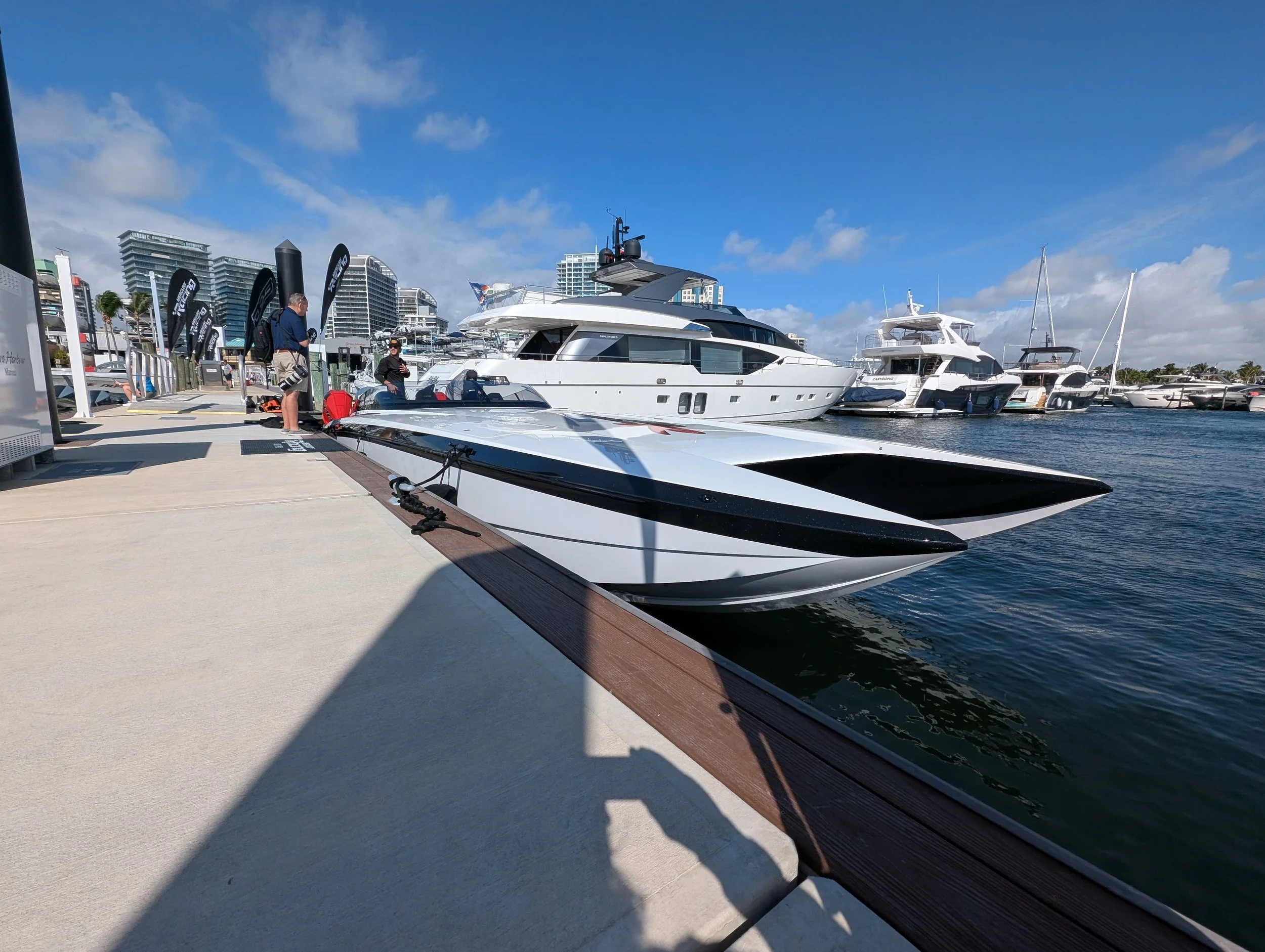Miami Boat Show 2024 Overview: Fast Boats, Bargains, and Accessories
Although I do attend the Miami Boat Show every year, I generally don’t love going to see the new boats. But, I do like seeing old friends and meeting people in the industry, that’s the best part for me. One other good thing about the Miami show is that it hosts many accessories and marine wholesalers. And the other thing about Miami is that it often is the show where companies announce new products. Instead of doing my usual walkaround video, I am going to talk about a few off the beaten path products I found, some of the new boats, and boats that are considered a bargain in this day and age.
If you have a millions dollars in your pocket earmarked for a new boat, the Miami Boat Show is a good place to start. With boat show specials everywhere, the $500k to $1.5 million segment is ripe with deals. But what if you aren’t a millionaire and you want to get on the water in something new with a warranty? The good news is there are some choices, just not that many. I looked at some of the new boats available and broke down a few that were actual bargains in the sense of how much money per foot, and the overall average value in that size range. Here are some options, it’s a short list. And, these aren’t performance boats, this is for getting on the water, possibly fishing or doing some island hopping.
The prevailing classic bargain on the water is Carolina Skiff. The venerable skiff and center console makers still offers their bread and butter flat bottom skiffs, solid glass construction and no frills layout. One advantage of a relatively light flat bottom is you don’t need much power to plane it out and run a respectable cruise speed. The bad news is your back will probably give out much earlier than you would hope. That said, for inshore and lakes that are calm, it’s not a problem.
The Carolina Skiff bottom is flat, very flat.
If you consider cost per foot, the Carolina Skiffs are best bargain new boats. I actually really like a no frills utility boat. The E24 DLX at the show was a CC model that also comes in an open version and starts at $39k with a 115, and with a trailer you can be on the water under $45k. With a 93” beam and a generous freeboard, the hull provides a ton of room and even though it won’t be breaking any speed records with a 115, you don’t need much power to cruise in a flat bottom. That was the best deal per foot at the show.
For a slightly smaller variation the E21 DLX features the same beam, center console or open, and with a 90 HP, you’re at 35K. That’s a phenomenal deal. The CC comes with a swim step and just what you need to get on the water. The larger displacement 90 HP engines on the market would be fine on this, I’d probably opt for tiller open version if you wanted to maximize space.
Although Carolina Skiff makes some other CC models with V hulls and more stuff, they end up losing their appeal a bit, but the traditional skiff has a place because it’s so versatile and has so much value.
Moving down the line, I actually like the Mako skiffs, they are low cost, no frills compact skiffs that have a neat look. Even though Mako has a great brand history, the mass manufactured boats they make now are value driven, yet have some decent styling cues.
The Pro Skiff line from Mako goes from 13, 15, 17, and 19 CC versions and all come with an optional color in the gel, a decent console with storage in the front, rod holder, cushioned seats and get you on the water for a great price. A 13 CC with a 25 is $17,950. That’s an incredible value. The hull is tri-hull that is mostly flat.
If you want to step up in size, the Pro 19 Skiff has a console, storage, rod holders and a bit better finish than the Carolina, and I’d argue a nicer overall design. The tri-hull design is quite flat but probably tracks better than a true flat skiff. With a 90HP, the boat is $38,900 with a trailer. Hard to beat that for a full warranty new boat. Again, these are the best bargains on the water, I can’t speak to the quality or anything.
When you go to the second floor of the Convention Center at the Miami show, you’ll find the accessories and some non power boats as well. Much of this area is wholesalers and retailers selling everything from lines, life jackets and lights, to knives, ladders and generators; virtually anything you need for your boat, you can find on the second floor. Here’s a rundown of a few things that caught my eye.
A great Christmas gift or the boater that has everything. No need for a truck to move the boat around
A product that has been around for a while and is getting more popular the last couple years are boat control tabs, I sort of made that term up, but essentially these are old technology married to modern software to automate ride control. The difference between these and traditional trim tabs is that these use a compact edge that deploys to creat varying degrees of lift instantly. The SeaKeeper Ride 450 for smaller boats extends 8” from the transom, the plastic edge can deploy or recess as needed. It works by forcing water down sharply, but without the extension a tab would have. This makes it quicker, instantly deployed and immediate but it doesn’t extend your running surface like a trim tab does.
The competitor to the SeaKeeper is ZipWake, and it works much the same way. Each product manipulates the running surface by an automated plastic wedge, and you don’t need much articulation to have a great effect. The disadvantage is that it doesn’t extend your running surface, and it introduces an incredible amount of drag. It works but I’d have to run them to see the results. I’d worry in turning in particular, because you may have unwanted bow down effect in certain situations, where the system would activate, you would initiate a turn and get bad bow steer.
These have no purpose for performance boats, as the automation and drag are disadvantages there. For those on a heavy fishing boat that don’t know how to use tabs, they could be useful I suppose. These range in price from about $3,000 and $4,500 for the small set, to upwards from there as you can add multiple units and you need a module to control them.
RIB jet boats are popular tenders and manufacturers like Williams, AB and Highfield had models on display. These are probably really fun to drive and I’d take one over a PWC, but usually these small RIBS perform terribly because they have bad hull designs, poor weight distribution, and are heavy. The high end ones are insanely expensive at $60k + for 14’ starting, and the lower end ones are around $35 to $40k for a 13’. Seems steep to me, but I’m old and out of touch probably.
On the cheaper end, you see more and more inflatables and molded plastic hulls for low HP electric outboards or just low HP gas engines. I have no problem with these, in fact I always find inexpensive ways to get on the water interesting. If you have a small lake or you just want to go beyond your dock to fish, or use a small dinghy, these work pretty well. I did an article on the Solo Skiff a couple years ago and that’s my favorite low cost micro boat.
A product I like are these roll on docks. You see them on the waterways in Florida a lot for PWC and small boats. I have also seen portable lifts that use an inflatable tube that goes under the hull, and a small vacuum motor fills the air to lift them, pretty neat. The roll on is nice because it’s so convenient and there is little in the way of mechanics. For PWC and small boats this is a great way to get it out of the water at your dock.
In the way of performance boats at the show, there was a stunning DCB M37R with 500Rs on the water. Inside MTI had a 440X, and their new 482 monster cat, which is a fresh design and it looks very much like the other stunning MTI’s in how it looks. That was the biggest new thing. No new engines, no major products that I saw. Cigarette did have a beautiful new 42X with twin Mercury Racing 1100s and they have several 515s being built. This is great news for the offshore sport boat market.
Sport Cats like the DCB M37R are still the hot ticket in performance boats.
The MTI 482 is a fresh design in the big boy cat market. A pretty stunning boat, and a market that MTI still does well in.
Seeing people from out of town and seeing some of the non performance boats is mostly why I go. I can almost imagine a show just for performance boats, and maybe it’s in a central location for more builders to access, could be a good idea.
Ilmor showed off their electric outboard by using triples on a blacked out Highfield RIB.
You see more and more catamaran designs in the fishing segment and now in the family cruiser segment as well. Four Winns has a big cat cruiser.
The Mercury ProXS lineup.
MTI 440X with twin 500Rs.





















